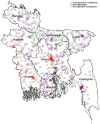Clustering of home delivery in Bangladesh and its predictors: Evidence from the linked household and health facility level survey data
- PMID: 38359056
- PMCID: PMC10868736
- DOI: 10.1371/journal.pgph.0002607
Clustering of home delivery in Bangladesh and its predictors: Evidence from the linked household and health facility level survey data
Abstract
Around half of births in Bangladesh occur at home without skilled birth personnel. This study aims to identify the geographical hot spots and cold spots of home delivery in Bangladesh and associated factors. We analyzed data from the 2017/2018 Bangladesh Demographic and Health Survey and the 2017 Bangladesh Health Facility Survey. The outcome variable was home delivery without skilled personnel supervision (yes, no). Explanatory variables included individual, household, community, and healthcare facility level factors. Moran's I was used to determine hot spots (geographic locations with notably high rates of home delivery) and cold spots (geographic areas exhibiting significantly low rates of home delivery) of home delivery. Geographically weighted regression models were used to identify cluster-specific predictors of home delivery. The prevalence of without skilled personnel supervised home delivery was 53.18%. Hot spots of non-supervised and unskilled supervised home delivery were primarily located in Dhaka, Khulna, Rajshahi, and Rangpur divisions. Cold spots of home delivery were mainly located in Mymensingh and Sylhet divisions. Predictors of higher home births in hot spot areas included women's illiteracy, lack of formal job engagement, higher number of children ever born, partner's agriculture occupation, higher community-level illiteracy, and larger distance to the nearest healthcare facility from women's homes. The study findings suggest home delivery is prevalent in Bangladesh. Awareness-building programs should emphasize the importance of skilled and supervised institutional deliveries, particularly among the poor and disadvantaged groups.
Copyright: © 2024 Fatima et al. This is an open access article distributed under the terms of the Creative Commons Attribution License, which permits unrestricted use, distribution, and reproduction in any medium, provided the original author and source are credited.
Conflict of interest statement
The authors have declared that no competing interests exist.
Figures




Similar articles
-
Exploring hot spots of short birth intervals and associated factors using a nationally representative survey in Bangladesh.Sci Rep. 2022 Jun 9;12(1):9551. doi: 10.1038/s41598-022-13193-2. Sci Rep. 2022. PMID: 35680970 Free PMC article.
-
Spatial distribution of caesarean deliveries and their determinants in Bangladesh: evidence from linked data of population and health facility survey.Lancet Reg Health Southeast Asia. 2023 Jan 31;14:100153. doi: 10.1016/j.lansea.2023.100153. eCollection 2023 Jul. Lancet Reg Health Southeast Asia. 2023. PMID: 37492410 Free PMC article.
-
Spatial variation in the non-use of modern contraception and its predictors in Bangladesh.Sci Rep. 2023 Aug 24;13(1):13814. doi: 10.1038/s41598-023-41049-w. Sci Rep. 2023. PMID: 37620501 Free PMC article.
-
Exploring spatial variations in level and predictors of unskilled birth attendant delivery in Bangladesh using spatial analysis techniques: Findings from nationally representative survey data.PLoS One. 2022 Oct 25;17(10):e0275951. doi: 10.1371/journal.pone.0275951. eCollection 2022. PLoS One. 2022. PMID: 36282794 Free PMC article.
-
Spatial pattern and influential factors for early marriage: evidence from Bangladesh Demographic Health Survey 2017-18 data.BMC Womens Health. 2023 Jun 20;23(1):320. doi: 10.1186/s12905-023-02469-y. BMC Womens Health. 2023. PMID: 37340425 Free PMC article.
References
-
- Maternal mortality. Accessed October 23, 2022. https://www.who.int/news-room/fact-sheets/detail/maternal-mortality
-
- Reinke E, Supriyatiningsih, Haier J. Maternal mortality as a Millennium Development Goal of the United Nations: a systematic assessment and analysis of available data in threshold countries using Indonesia as example. Journal Global Health. 7(1):010406. doi: 10.7189/jogh.07.010406 - DOI - PMC - PubMed
LinkOut - more resources
Full Text Sources
